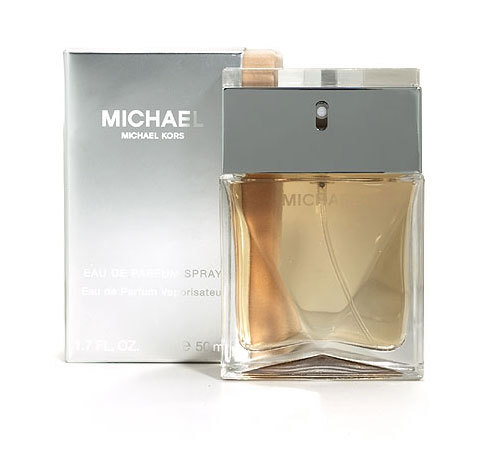Michael Kors Eau de Parfum (2000): Chinese Spice Box Folded into a White Bouquet {Perfume Review}

And then things start to smell really interesting. Michael as it turns out offers a trompe l'oeil effect which is fascinating like all elaborate plays on illusion and the revelations of secret drawers in the family furniture. You may think the scent is a white floral bouquet but its structure is in fact supported by an antithetical element: the spicy oriental and none other than the most classic of all since the 1970s: Opium by Yves Saint Laurent originally composed by perfumer Jean-Louis Sieuzac in 1977.
The Spice-Box Accord
I found this quote on the Macy's site and whoever wrote this is absolutely and literally right,
"Creamy florals meet exotic spices, tamed by Moroccan incense."
Michael, as it was initially named when it launched in 2000, was created by nose Laurent Le Guernec and Alain Alchenberger (added in 2016: cf. chemist Philip Kraft who gave the name of the latter) who have had the audacity to incorporate the oriental accord best-known to most into a tuberose composition meant to smell clean and uncomplicated, perhaps even evoke the sun and the beach. The following sequels of Michael Kors Island flankers certainly show an attraction for the escapist vacation theme. It is a brilliant reversal of expectations and adds subliminal complexity to the composition.
The perfume offers an exotic Chinese twist à la Opium by Yves Saint Laurent, thanks to Chinese osmanthus, tamarind, peony, pepper and incense. It is directly inspired by the East Asian spice box effect of Opium complete with amber-y undulations but brilliantly and unexpectedly ensconced in the middle of a white floral bouquet like an Opium flanker in reverse proportions: the white floral accord is no longer an appendage but the main motif while the Japanese Inro box filled with precious Chinese ingredients remains as a moiré, nearly undefinable impression. This oriental facet brings also a layer of warmth and resinous depth to the scent which intensifies rather than competes with the dewy sensual creaminess, even butteriness, of the white flowers which never feel weighed down.
In August 2000, Kors had this to say about his debut fragrance,
"It's glamorous but simple, indulgent but practical," ..."We have a very opinionated customer--and I like something that causes a reaction. My mother wore my fragrance in New York, and four cabdrivers asked her what it was." (W magazine, August 1, 2000)
The designer also added that he wanted the perfume to feel timeless to ensure its prolonged success and that this was the most difficult part of the job,
"I loved smelling the submissions," he says. "The toughest thing to do is come up with something that doesn't smack of a specific time period. If it's really timeless, it'll hold up."
- and it did.
This success is not due to the fact in my view that there is a well-known accord inside the perfume - a commercial trick meant to lasso in conservative noses - but rather because the alliance of a heady and fresh tuberose with a lacquered spice-box accord conjuring up the Middle Kingdom should not have logically seen the day of light but it did and to the best effect. Even after you realize it is there, you still marvel at not just the intuitive jump Le Guernec made but the unanticipated contrasted harmony it creates.
To use a food analogy, it gives me a similar sensation as when you eat a Chevrotin des Aravis, a Reblochon cheese made with raw goat milk. Your tastebuds expectations are fooled by the incongruous sensation of a morphing cheese where cow milk has been replaced by goat milk.
The Leather Accord
Another very interesting olfactory illusion you can deconstruct is the presence of a secret leather note which is not even mentioned in the list of perfume ingredients. The distinctive signature of Michael Kors is due in good part to a well-hidden kid-like smoky Iso Butyl Quinoline leather note reminiscent of the soft leather skin accord found in Dzing! by L'Artisan Parfumeur created by perfumer Olivia Giacobetti. It surges very distinctively when you smell the scent next to other white floral compositions; in my case Mariah Carey Forever was the key to this hidden note.
Michael Kors and Kim Kardashian
As I went back to Michael Kors EDP in the wake of the launch of Kim Kardashian EDP, I thought I would make a few comparative notes.
Michael Kors is similar to the new Kim Kardashian perfume only in that it teases the classic big white Southern floral accord, a favorite of the American market. It is immediately also softer and woodier. Personality-wise, it does not have the grittiness of KK EDP, this I-will-be-in-your face--until-you-pay-attention-to-me character and is more rapidly mysterious and exotic (East Asia; Morocco) with much more tuberose too. It is rounder and less sharp while Kim Kardashian revolves around a very sustained indolic accord. Michael Kors is thus more for subtle souls than Kim Kardashian eau de parfum and delectable in a more refined, private way: I can imagine myself wearing this perfume in the private dining room of a Chinese restaurant in Shanghai hidden by lacquered wind screens.
KK is absolutely and clearly the perfume of a TV reality star, whose whole life seems thrown into the open and whose central meaning rests on appearances, while the Michael Kors woman cultivates a sense of privacy and intimacy.
Notes: Dewy Freesia, Tamarind, Chinese Osmanthus, Incense, Fresh Tuberose, White Wings Peony, Blue Orris, Arum Lilies, Cashmere Woods, Musk, Vetiver Haiti.









